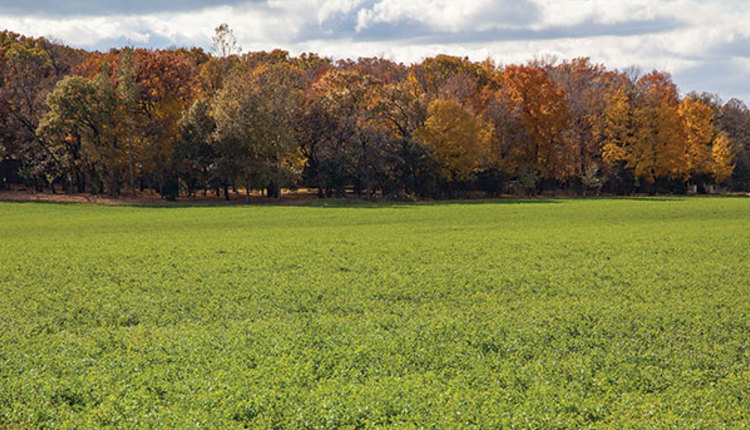
Summer and winter alfalfa are different in structure. The change occurs during the process of hardening in the fall to allow the alfalfa plant to survive colder temperatures.
During hardening, the membrane of fatty acids around each cell becomes more unsaturated (more double bonds between carbon atoms). A saturated membrane allows for freer movement of carbohydrates out of the cell and minerals into the cell; this is better for summer growth and reserve-building in taproots. However, an unsaturated membrane can survive colder temperatures without solidifying, which would cause cell death.
The hardened cells also have a higher sugar content. These sugars act as an antifreeze, allowing the cell contents to remain liquid at lower temperatures. This is the same reason regular Coke or 7-Up freezes at colder temperatures than the diet versions with less sugar. Alfalfa does this by breaking down root and crown starches to produce sugars that accumulate in cells. This allows supercooling of the cell solution (cooling below 32°F without freezing).
The elevated cell sugar content and other changes cause ice formation in spaces between plant cells rather than inside the cell. Water loss from inside cells is reduced with extracellular freezing (most winterkill is actually due to desiccation, or water loss, from cells). The hardened cells stabilize larger molecules and membranes within the cell.
Genetics matter
Hardening begins in the fall when the plant crown temperature is 60°F. Maximum hardening occurs when the air temperature is between 40 and 50°F. The process is enhanced by fluctuating temperatures with highs around 50°F and lows near freezing. How much the plant hardens depends both on the plant’s genetic potential and proper weather conditions.
We can think of hardening as a sliding scale with 100 percent of genetic potential developed with two to three weeks of cool days and near freezing nights. Less of the genetic potential for winter hardening develops with a shorter period of fluctuating temperatures. Thus, alfalfa hardening of a given variety and its ability to survive winter will be greater in some years than others depending on the fall weather. In 1992, Wisconsin alone lost over 1 million acres of alfalfa when temperatures were 70°F until December 1 and a killing frost occurred before any winter hardening.
Other factors
Previous crop management also affects the degree of hardening. Low soil fertility reduces winter survival, particularly low soil pH and low levels of soil potassium and sulfur. More frequent cutting regimes require more winterhardiness because plants have less time between cuttings to replenish root carbohydrates.
While short intervals are necessary for the high-quality hay/haylage needed by the dairy industry, a longer cutting interval is why alfalfa often survives longer if it is harvested at later stages for beef cattle. Additionally, late fall cutting, while often recommended, puts more stress on alfalfa and requires a higher level of winterhardiness.
Although fall dormancy is no longer strongly linked with winter survival, it still can have an impact. Fall dormancy is determined by the height of growth during September. Less fall dormancy (higher numbers) relates to earlier spring green up and faster green up after cutting; this often results in more yield. However, more dormant cultivars harden up to three times faster than less dormant cultivars and tend to have deeper crowns that protect plants against cold weather in the absence of snow.
Dehardening and the initiation of shoot growth occurs when the air temperature is greater than 60°F during the day and when the soil temperature at 2 to 4 inches is above 40°F. Dehardening may take five to six days of these conditions for a fall dormancy 3 variety and three to four days for a fall dormancy 4 to 5 variety. Thus, if you farm in an area that has periods of warm days over winter with lack of snow, be wary of less fall dormant types as they will lose dormancy quicker. In addition, shoots from buds formed in the fall will start to grow using root reserves intended for spring growth.
An alfalfa plant can usually survive one such growth period if it went into the winter healthy. However, spring green up will be slow because the alfalfa must develop new buds for spring growth because the fall buds started to grow and died during the colder weather.
Evaluate during spring
It’s relatively easy to determine if you lost some of the fall-established buds on the plant by looking at the pattern of spring growth. If growth is of uniform height, then most buds survived the winter. If, on the other hand, spring growth starts with only a few shoots and others develop later, then winter injury occurred. The later shoots will tend to be 2 to 4 inches shorter than the shoots from buds that survived the winter.
Alfalfa is an amazing plant with dormant types allowing it to survive most winter conditions. Selecting proper genetics for the region and using good agronomic practices will generally allow the alfalfa to come through the winter healthy, change its physiology for the growing season, and ready itself for rapid growth in the spring.
This article appeared in the November 2018 issue of Grower on page 24.
Not a subscriber? Click to get the print magazine.

